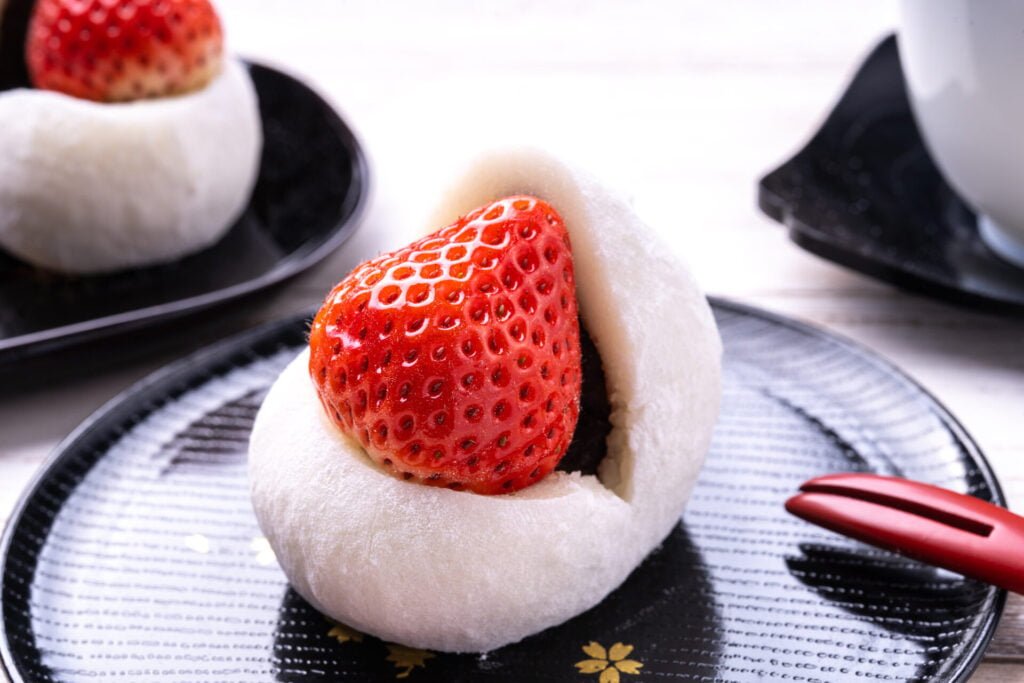Daifuku Mochi: A Timeless Icon in the Realm of Wagashi and Japanese Sweets
In the diverse world of wagashi and Japanese sweets, Daifuku mochi stands out as a beloved classic. This simple yet exquisite Japanese dessert, with its soft mochi exterior and sweet filling, has captivated taste buds for centuries. Join us as we explore the history, variations, and cultural significance of Daifuku mochi in the landscape of traditional Japanese confectionery.
The Origins of Daifuku: A Sweet Legacy in Japanese Dessert History
The history of Daifuku mochi dates back further than many might imagine, tracing its roots to the late Muromachi period. Its predecessor, a confection called “uzura mochi,” is believed to be the origin of Daifuku mochi. Uzura mochi, named for its resemblance to quail eggs, differed from modern Daifuku mochi in that it contained salty bean paste rather than sweet filling.
The name “Daifuku” has an interesting etymology. Uzura mochi was known for its filling nature and was called “harabutomochi” (belly-filling mochi) or “harafutomochi” (fat-belly mochi). Over time, these names evolved into the more auspicious “Daifuku,” which means “great fortune.”
Anatomy of a Classic: The Art of Crafting Daifuku Mochi
At its core, Daifuku mochi is beautifully simple: a thin layer of mochi wrapped around a sweet filling. This simplicity allows the quality of ingredients and the skill of the artisan to shine through.
The mochi outer layer is made by steaming and pounding glutinous rice or Gyuhi to achieve the perfect balance of stickiness and softness. The filling, typically anko (sweet red bean paste), is made by cooking azuki beans with sugar until smooth. The combination of these two elements creates the unique texture and flavor profile that defines Daifuku mochi.
Mame Daifuku: An Innovative Twist on Traditional Japanese Sweets
Mame Daifuku is a variation that adds whole sweet beans to the traditional Daifuku mochi filling. This small change adds a new dimension to the texture and flavor of the mochi treat. The addition of whole beans to the smooth anko provides a textural contrast and a more complex flavor profile. Visually, the beans peeking through the translucent mochi skin create an appealing appearance.
Regional Daifuku Varieties: Exploring Japan’s Diverse Wagashi Culture
One of the charms of Daifuku mochi lies in its versatility. Beyond the classic red bean filling, there are numerous variations:
Strawberry Daifuku mochi (Ichigo Daifuku), which wraps a whole strawberry in anko and mochi, is a popular springtime treat. Matcha Daifuku mochi incorporates green tea powder into the mochi for a sophisticated flavor. Yuzu Daifuku mochi adds a citrusy note to the sweet confection.
Regional specialties also abound. In Hokkaido, “cream Daifuku mochi” filled with fresh cream is famous. Okinawa boasts “beni-imo Daifuku mochi,” which uses the local purple sweet potato.

Daifuku in Japanese Culture: More Than Just a Sweet Treat
As its name suggests, Daifuku mochi is considered a harbinger of good luck in Japanese culture. It’s often eaten during special occasions and holidays, particularly during Setsubun, as a way to invite happiness and prosperity.
The round shape of Daifuku mochi is said to symbolize harmony, representing wishes for family unity and smooth interpersonal relationships. In this way, Daifuku mochi transcends its role as a simple sweet and becomes a cultural symbol.
The evolution of the name from “harabutomochi” to “Daifuku mochi” reflects a shift in the cultural values associated with the confection. While the former name highlighted its practical aspect of being filling, the latter emphasizes its role as a bringer of good fortune.
Modern Innovations: Daifuku’s Evolution in Contemporary Japanese Desserts
In modern times, the concept of Daifuku mochi has inspired new creations. Seasonal fruit Daifuku mochi and Western-inspired variations have emerged, showcasing the adaptability of this traditional mochi sweet.
Perhaps the most notable modern interpretation is “Mochi ice cream.” Developed by Japanese-Americans in the 1990s, this fusion dessert wraps ice cream in a thin mochi layer. It has gained immense popularity worldwide, available in a variety of flavors in supermarkets across the globe. This innovation represents how traditional Japanese mochi confectionery concepts can be adapted and appreciated on an international scale.

Conclusion: The Enduring Appeal of Daifuku Mochi
Daifuku mochi, in all its forms, continues to be a beloved staple in the world of wagashi and Japanese sweets. From its humble origins to modern interpretations like mochi ice cream, Daifuku exemplifies the adaptability and enduring appeal of traditional Japanese desserts. As you explore the rich world of Japanese confectionery, remember that each Daifuku you taste is not just a sweet treat, but a bite-sized piece of Japan’s culinary heritage and cultural identity.
